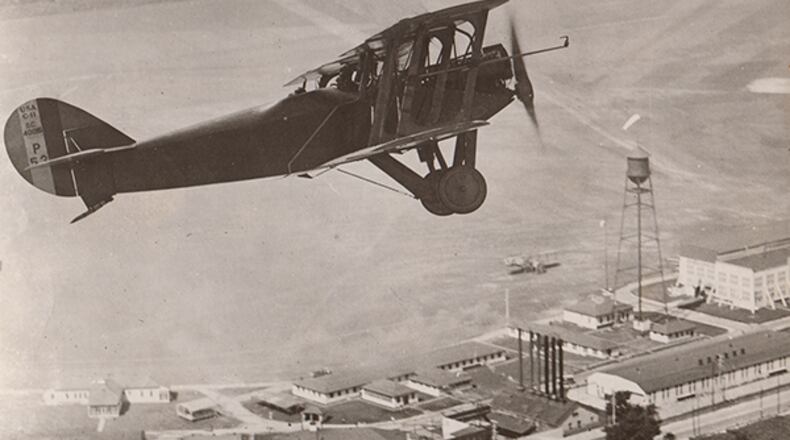The local protectiveness around military functions and history — seen today in organizations like the Dayton Development Coalition, the Dayton Area Chamber of Commerce and the Dayton Aviation Heritage National Historical Park — was present from the beginning.
“Without that critical piece — without that Chamber of Commerce stuff — it (early aviation work) likely would have left entirely and gone somewhere on the East Coast,” said Kevin Rusnak, chief historian of the Air Force Life Cycle Management Center at Wright-Patterson.
“Dayton even back then had adopted this mindsight that Dayton was the birthplace of aviation,” said Steven Byington, cultural resources manager for the 88th Civil Engineer Group at Wright-Patterson.
The birthplace of aviation
Substantial research into sustainable flight began here in Dayton. In a real sense, it never left. Wright-Patterson is the locus of Air Force research, logistics and sustainment.
After their historic first flight above a North Carolina beach on Dec. 17, 1903, the Wright Brothers started the heady business of learning to fly at Huffman Prairie in 1904, with permission of the field’s owner, learning to turn, fly circles, figure 8s and more, Rusnak said.
There in northwestern Greene County, the brothers established a school for people buying their planes. Part of the U.S. Army’s first contract involved the brothers teaching Army students how to fly the planes the military bought.
Among those first students was future Air Force five star general Hap Arnold, around 1911 or 1912.
Dayton’s McCook Field became another formative location in the building of what became an Air Force base. Wilbur Wright died in 1912. World War I sparked the furtherance of aviation, inspiring the creation of flying schools across the country.
The nation realized it needed to expand its supply of planes in order to fly a war. “We needed to build and buy a lot of airplanes; we needed to crank out thousands of pilots,” Rusnak said.
“We needed to create all that infrastructure to provide all of this,” he added. “These sites grew up around the country. Dayton happened to be one of those.”
Why Dayton? It was connected to the Wright Brothers — and also to another important local figure.
Edward Deeds, a classic early 20th century industrialist, became an Army Reserve officer in charge of supplying the nation’s early air service. Rusnak sees Deeds as someone protective of Dayton’s place as an industrial center.
McCook Field and more
A litany of familiar names quickly pops up in the history books: When Wilbur Wright Field began pilot training work in 1917 (near today’s Area A of Wright-Patterson), it helped form what became a trio of aviation-focused sites, with McCook Field in Dayton and the Fairfield Aviation General Supply Depot, a logistics operation near Wilbur Wright Field.
That logistics function may have slowed in the period between the first and second world wars. But the seeds of what became Wright-Patterson were being planted.
McCook, a small triangle of land near downtown Dayton, was home to early aeronautical research on engines, propellers, lubricants and much else besides.
Threats to all of this loomed from the beginning.
‘Thanks for donating this’
Soon enough, there was was talk of moving those Wilbur Wright Field functions to bases in Texas and Alabama.
“You don’t really want brand new pilots learning to fly in the ice and snow and bad weather in Dayton,” Rusnak said.
So Dayton’s operations switched to training armorers and mechanics early in the First World War.
Still, the threat to local operations lingered. Schools devoted to training closed as the Great War ended.
And airplanes were getting bigger, faster and more dangerous. “Occasionally, they would have airplane crashes into houses,” Rusnak said.
By the early 1920s, the writing was feared to be on the wall for McCook Field and other fledgling aviation functions — and local residents sprang into action.
Like Deeds, National Cash Register founder John Patterson understood the importance of keeping engineering work to Dayton.
Community leaders banded together to create the “Dayton Air Services Committee” to convince the government not to move those functions.
In 1924, the group had a two-day fundraising campaign, raising well over $400,000 to purchase land from the Miami Conservancy District — the area’s multi-county flood control effort — to give to President Calvin Coolidge and the U.S. government.
“I actually have the copy of the letter from President Coolidge saying, ‘Thanks for donating this,’” Rusnak said.
“It’s definitely a considerable amount, considering they did it only in about 48 hours,” said Byington, the 88th Civil Engineer Group’s cultural resources manager. “That was really where the business community of Dayton realized that aeronautics and aviation was going to be sort of a long-term investment for the city of Dayton.”
“They really put their money where their mouth was in terms of wanting that industry to stay in the area,” he said.
In 1926, federal money was allocated, with a groundbreaking on today’s Area B.
Area B (Wright Field) was the home of the engineering function. And Area A (Patterson Field) focused on logistics. Today’s State Route 444 became the dividing line between the two areas.
About the Author




